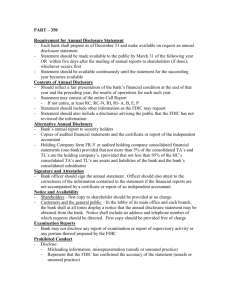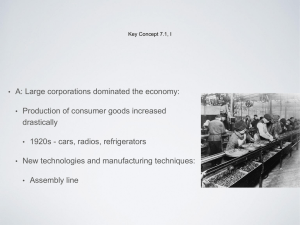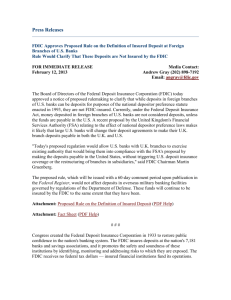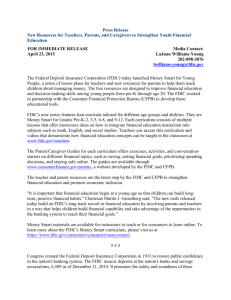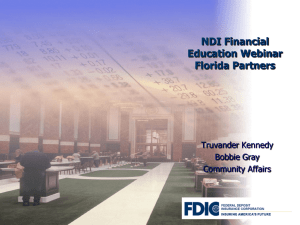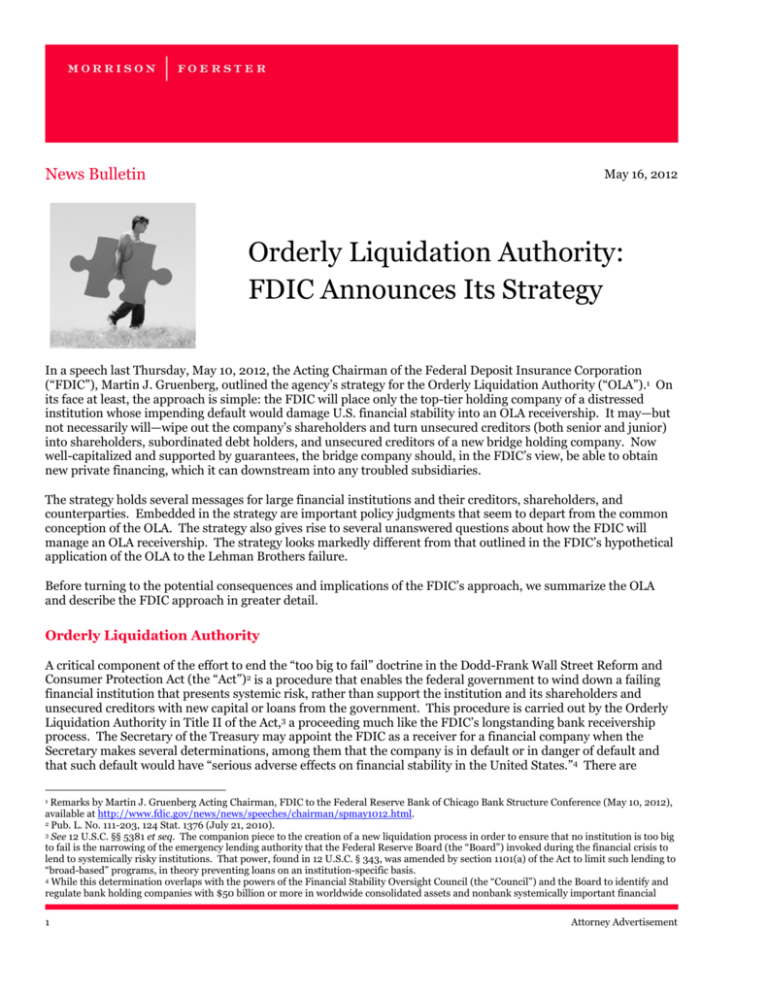
News Bulletin
May 16, 2012
Orderly Liquidation Authority:
FDIC Announces Its Strategy
In a speech last Thursday, May 10, 2012, the Acting Chairman of the Federal Deposit Insurance Corporation
(“FDIC”), Martin J. Gruenberg, outlined the agency’s strategy for the Orderly Liquidation Authority (“OLA”).1 On
its face at least, the approach is simple: the FDIC will place only the top-tier holding company of a distressed
institution whose impending default would damage U.S. financial stability into an OLA receivership. It may—but
not necessarily will—wipe out the company’s shareholders and turn unsecured creditors (both senior and junior)
into shareholders, subordinated debt holders, and unsecured creditors of a new bridge holding company. Now
well-capitalized and supported by guarantees, the bridge company should, in the FDIC’s view, be able to obtain
new private financing, which it can downstream into any troubled subsidiaries.
The strategy holds several messages for large financial institutions and their creditors, shareholders, and
counterparties. Embedded in the strategy are important policy judgments that seem to depart from the common
conception of the OLA. The strategy also gives rise to several unanswered questions about how the FDIC will
manage an OLA receivership. The strategy looks markedly different from that outlined in the FDIC’s hypothetical
application of the OLA to the Lehman Brothers failure.
Before turning to the potential consequences and implications of the FDIC’s approach, we summarize the OLA
and describe the FDIC approach in greater detail.
Orderly Liquidation Authority
A critical component of the effort to end the “too big to fail” doctrine in the Dodd-Frank Wall Street Reform and
Consumer Protection Act (the “Act”)2 is a procedure that enables the federal government to wind down a failing
financial institution that presents systemic risk, rather than support the institution and its shareholders and
unsecured creditors with new capital or loans from the government. This procedure is carried out by the Orderly
Liquidation Authority in Title II of the Act,3 a proceeding much like the FDIC’s longstanding bank receivership
process. The Secretary of the Treasury may appoint the FDIC as a receiver for a financial company when the
Secretary makes several determinations, among them that the company is in default or in danger of default and
that such default would have “serious adverse effects on financial stability in the United States.”4 There are
1 Remarks by Martin J. Gruenberg Acting Chairman, FDIC to the Federal Reserve Bank of Chicago Bank Structure Conference (May 10, 2012),
available at http://www.fdic.gov/news/news/speeches/chairman/spmay1012.html.
2 Pub. L. No. 111-203, 124 Stat. 1376 (July 21, 2010).
3 See 12 U.S.C. §§ 5381 et seq. The companion piece to the creation of a new liquidation process in order to ensure that no institution is too big
to fail is the narrowing of the emergency lending authority that the Federal Reserve Board (the “Board”) invoked during the financial crisis to
lend to systemically risky institutions. That power, found in 12 U.S.C. § 343, was amended by section 1101(a) of the Act to limit such lending to
“broad-based” programs, in theory preventing loans on an institution-specific basis.
4 While this determination overlaps with the powers of the Financial Stability Oversight Council (the “Council”) and the Board to identify and
regulate bank holding companies with $50 billion or more in worldwide consolidated assets and nonbank systemically important financial
1
Attorney Advertisement
several procedural prerequisites and protections, including recommendations by the Board and the FDIC and
expedited judicial review.
Once the FDIC is appointed as a receiver, it may operate and liquidate the institution as it sees fit, with nearly the
same powers that it may exercise as receiver for a failed bank.5 The Act contemplates that the FDIC will attempt
to break up an institution and sell off various of its assets or operating subsidiaries.6 Moreover, many institutions
potentially subject to the OLA are required by section 165(d) of the Act to produce a resolution plan in part in
order to give the FDIC a roadmap for its orderly liquidation.7 The FDIC can obtain funding from the Orderly
Liquidation Fund (“OLF”) for the orderly liquidation by issuing obligations to the Treasury Secretary. The
Secretary must approve both an orderly liquidation plan and a five-year repayment plan from the FDIC before the
OLF releases funds. If the FDIC does not have sufficient funds from the liquidation to pay its obligations to the
Secretary within 60 months, the FDIC may assess bank holding companies with total consolidated assets of $50
billion or more and any nonbank financial companies that have been designated as systemically important for the
necessary funds.
The FDIC’s Assumptions
The approach outlined in Mr. Gruenberg’s speech rests on a number of assumptions about the differences
between a traditional bank receivership and the resolution of a large financial institution under the OLA. These
assumptions appear to have dictated the FDIC’s new strategy, created new questions about the nature of an OLA
receivership, produced new policy decisions, and produced market considerations that industry participants may
not previously have appreciated. The stated assumptions are as follows:
1.
The proximate cause of distress will be liquidity pressure, rather than a capital deficiency. Banks
usually have a stable source of funding, even under adverse conditions, in insured deposits. Large
financial institutions, by contrast, rely more extensively on short-term wholesale funding, which
is highly volatile and sensitive to changes in the financial condition of a borrower. Liquidity
pressure in this situation carries with it the need for almost immediate intervention.
Implicit in this belief is a further assumption that an institution in an OLA receivership will be
solvent pursuant to regulatory capital rules.
2.
Large financial institutions have more complex corporate structures, which means that any effort
to conduct a resolution on a business-by-business basis involves greater risks of disruption in
business operations and loss of franchise value.
3.
The size of an institution alone means that there will be few, if any, viable buyers. The return of
the institution to private hands will have to be accomplished through some means other than a
sale.
institutions, the universe of institutions subject to the Orderly Liquidation Authority is different in two respects from that of institutions
covered by Title I. First, a financial company need not exceed the $50 billion threshold (if it is a bank holding company) or have been deemed
systemically important by the Council in order to be placed in the OLA; it is enough that the Secretary determines that the institution’s
imminent default will at that time have serious adverse effects. Second, only holding companies organized under state law in the United States
can be placed in the OLA; holding companies organized abroad cannot. However, a U.S. bank holding company that is a subsidiary of a
foreign bank could be sent into the OLA.
5 Indeed, a defaulting institution in OLA may be the parent of a failing U.S. bank, which would result in the FDIC operating two receiverships
at the same time—an interesting result since in current parallel insolvency proceedings the FDIC as bank receiver and the bankruptcy trustee
for the bank holding company frequently have competing claims to the same assets.
6 For example, the FDIC is expected to repay any borrowings to finance a distressed institution in part with income from the liquidated assets
of the institution. See 12 U.S.C. § 5390(n)(9)(B)(i)(II).
7 Per our discussion in note 4, supra, an institution in OLA would not necessarily have been required to submit a resolution plan.
2
Attorney Advertisement
Although not an assumption, a fundamental difference between a bank receivership and an OLA receivership
informs the FDIC’s implementation of the OLA. In a bank receivership, the FDIC’s actions are based on its twin
roles as a bank insurer, where its objective is to minimize the costs of the receivership to the Deposit Insurance
Fund (“DIF”), and as a resolution authority, where its goal is to remove a failed bank from the banking system.
The FDIC may use funds in the DIF for financing, including paying off depositors and supporting loss-sharing
arrangements with bank purchasers. By contrast, in the OLA process, the FDIC has no insured depositors or
insurance fund to protect. Instead, it is solely a resolution authority with a far more challenging task, the
elimination of defaulting and complex financial institutions from the financial services industry while preventing
or mitigating any adverse effects on U.S. financial stability.
The Strategy for the OLA
The FDIC’s strategy for an institution in danger of default that could have serious adverse effects on U.S. financial
stability involves five initial and contemporaneous steps:
1.
The Secretary of the Treasury appoints the FDIC as receiver for the top-tier holding company of
the institution.
2.
The FDIC as receiver sells the assets of the institution—its ownership interests in its
subsidiaries—to a bridge holding company. In return, the FDIC receives all of the equity interests
in the bridge company. The receivership retains all of the liabilities.
3.
As the sole shareholder of the bridge company, the FDIC elects the bridge company’s first board
of directors and appoints a CEO. (In the meantime, it will have dismissed the directors and
senior management of the holding company.)
4.
The first order of business for the bridge company will be to obtain financing. According to Mr.
Gruenberg’s speech, funding will be available from either the OLF, the capital markets, or some
combination of the two. The FDIC appears to prefer private borrowing by the bridge company,
supported by guarantees from the OLF. Any guarantees should operate in much the same way as
the Debt Guarantee Program during the financial crisis.8
5.
However, timing considerations dictate that initial funding will come from the OLF.9 In order to
obtain the funds as quickly as possible for an institution in receivership or the bridge company,
the FDIC will have to have submitted resolution and repayment plans to the Secretary and
received approval before its formal appointment as receiver, and to have arranged the sale of debt
securities to Treasury.
These steps can be taken within a matter of hours. The timing considerations in a bank receivership should apply
equally here: the institution presumably will be placed into the OLA after the close of business in the U.S. on one
business day, typically a Friday, and the bridge company will be up and running before the markets open on the
following business day, usually a Monday.
The Debt Guarantee Program (“DGP”) was one of the two principal components of the FDIC’s Temporary Liquidity Guarantee Program. The
DGP guaranteed (up to certain limits) the newly issued senior unsecured debt of insured depository institutions, their holding companies, and,
if the FDIC approved, their affiliates. Guarantees under the DGP were to be paid out of the Deposit Insurance Fund (“DIF”), and participants
in the program were required to pay special assessments to the DIF. The OLF, by contrast, is wholly separate from the DIF. To the extent that
the FDIC cannot pay within 60 months the obligations that it had issued to Treasury, the FDIC will assess all bank holding companies with
total consolidated assets of $50 billion or more and all nonbank financial institutions that the Council has deemed systemically important.
9 In order to obtain funding from the private sector, the bridge company must either issue debt privately or register debt securities with the
Securities and Exchange Commission.
8
3
Attorney Advertisement
The FDIC plans to begin the transition away from FDIC ownership to private ownership of the bridge company
promptly, but the process will take several weeks at a minimum. The unsecured creditors and the subordinated
debt holders will hold claims against the receivership (but not against the bridge company).10 The assets of the
receivership will be the equity in the bridge company, and the FDIC will pay a portion of the claims with this
stock. The distribution of stock will follow the standard priorities. Unsecured creditors will also receive
subordinated debt and new unsecured debt in the bridge company. Once the stock in the bridge company has
been distributed, the new shareholders will elect a new board and appoint a new CEO. Notably, this resolution
process does not include any new capital investments; the bridge company is capitalized solely by the conversion
of unsecured debt into equity.
Decisions for the FDIC
Acting Chairman Gruenberg’s speech leaves unanswered several questions about the FDIC’s actions as receiver
that will be critical to senior and other unsecured creditors, as follows:
z
Will the FDIC transfer all of the assets of the distressed institution to the bridge company? It
seems likely that it would. The assets of the institution will be stock in its subsidiaries and not,
for example, problem loans or other credit exposures. The FDIC could retain particular
subsidiaries in the receivership. These businesses are likely to be the source of the loss of
liquidity, however, and placing these entities in the receivership is likely to aggravate rather than
mitigate liquidity concerns—a result contrary to the FDIC’s goal of orderly resolution.
z
As the owner of the bridge company, how will the FDIC deal with liquidity issues of the
subsidiaries? Loss of liquidity typically occurs at particular subsidiaries, rather than at the toptier holding company itself. There are at least two problems for a subsidiary perceived to be
unable to repay its wholesale funding: it will not receive new funding and creditors will move to
seize the collateral securing the current funding. To remedy this situation, the bridge company
will have to obtain support from the FDIC (which in turn will rely on the OLF), in the form of
either a direct loan (which could then be used to refinance the subsidiary’s debt) or a guarantee
of replacement funding (which is the FDIC’s preferred approach).
z
Would the FDIC nevertheless retain subsidiaries in the receivership in order to wind them down
or sell them off, or would the bridge company consider winding down or selling off subsidiaries?
Both the FDIC and the bridge company have this authority over subsidiaries. As a practical
matter, winding down may be inordinately difficult. A sale of the assets and liabilities or of the
subsidiary itself could maximize the viability of the company going forward. In effect, however,
it would benefit the senior unsecured creditors of the top-tier company at the expense of the
unsecured creditors at the subsidiary. Conceptually, senior unsecured creditors rank above
other unsecured creditors, so this result may not be inequitable (in this case, of course, the two
sets of creditors are not in direct conflict). From a liquidity perspective, however, this result
would deter unsecured creditors generally, making liquidity more expensive or difficult to
obtain.
z
Would the FDIC place a subsidiary in bankruptcy? Where the liquidity issues at a subsidiary are
sufficiently severe, an insolvency proceeding could be the best way to maximize the condition
and viability of the bridge company going forward. This result would, however, involve the same
competition between senior and other unsecured creditors that exists in a sale, as described
above.
10 If, as the FDIC appears to assume, the institution will be solvent when placed into the OLA, then there should be some value—common stock
in the bridge company—for the shareholders of the institution after the unsecured creditors have been recompensed.
4
Attorney Advertisement
z
Could a bank subsidiary be placed in a separate FDIC receivership? This issue is not a decision
for the bridge company but rather for the bank’s prudential regulator. The regulator certainly
could do so, and probably would under the standard criteria for a receivership. Again, this result
places senior unsecured creditors at the holding company at odds with the unsecured creditors at
the bank level—but it is an issue that exists in nearly every bank receivership and that is not
controllable by the holding company. The issue is, however, complicated by the FDIC’s
additional duty to resolve the bank at the lowest possible cost to the DIF.
z
How will the FDIC determine the mix of common stock, subordinated debt, and other junior
debt to be provided to unsecured creditors of the institution in an OLA receivership? The speech
refers to this issue but does not provide any details on the FDIC’s method for the determination.
Policy Decisions
The process that the Acting Chairman has outlined reflects several unstated policy judgments that may, over time,
have significant consequences.
5
z
Much of the unsecured debt of a holding company subject to the OLA has now become bail-in
debt. The effect on the market for senior unsecured debt could be severe. The European market
for senior unsecured debt seized up early in 2011 based on fears that debt would be bailed in to a
troubled or failing institution.
z
In substance, the FDIC approach may not be a liquidation at all: the institution will neither be
wound down nor sold, although its creditors and shareholders will be affected significantly.
Exactly how the FDIC will address the business operations of the subsidiaries that gave rise to
the liquidity crisis is unclear. While there evidently are no plans to appoint the FDIC as receiver
for a subsidiary that has created systemic risk, the FDIC will be the controlling shareholder and
can choose to wind down the subsidiary, sell it off, reorganize the subsidiary within the
institution’s corporate structure, refinance the subsidiary, or recapitalize it—or, if the subsidiary
is insolvent on a stand-alone basis, place the subsidiary into bankruptcy. (Presumably private
creditors could force an insolvent subsidiary into bankruptcy as well.)
z
The insolvency process could continue to have a central role—and perhaps the central role—in
the resolution of a distressed institution. Liquidations or resolution of the troubled business
units that created the institution’s default are certain to occur, and bankruptcy and bank
receiverships may well be the forums for this activity. As the number of proceedings outside the
OLA grows, the orderliness of an institution’s overall resolution may be more difficult to control.
z
In short, the FDIC’s approach appears to avoid micro-management of a large and complex
banking institution but at possibly a higher risk of a disorderly resolution.
z
If the assumptions that an institution’s failure is the result of liquidity losses rather than capitalinsolvency concerns and that the institution is solvent hold, then shareholders will not
necessarily be wiped out. Indeed, they could realize some value, a result unheard of in the bank
receivership process.
z
The bridge company serves a much different purpose in the OLA process than in a bank
receivership. Under the OLA, a bridge company is not really a “bridge” to anything. Rather, the
company is a refinanced and nominally recapitalized version of the failed institution, with some
of the same stakeholders, albeit with different stakes. By contrast, the FDIC has used the bridge
Attorney Advertisement
company in bank receiverships to facilitate the sale of good assets to a new buyer and the
liquidation of bad assets.
z
It is unclear what utility a resolution plan (or “living will”) under section 165(d) of the Act now
has as a guidepost to orderly liquidation. To the extent that the FDIC leaves the operating
subsidiaries of the top-tier holding company alone, the resolution scenarios in such a plan would
not be pertinent. Put another way, the FDIC’s focus in an OLA receivership is on liquidity;
elements of a plan that do not address liquidity may be less important for OLA purposes. As one
consequence, we would expect the FDIC to concentrate on liquidity when reviewing a resolution
plan. The Board’s assessment of a plan might also be affected. An institution required to file a
resolution plan accordingly should devote careful attention to the continuing availability of
liquidity.
Considerations for Institutions and Market Participants
For institutions and their investors, creditors, and counterparties, a few points are apparent:
6
z
The new convertibility feature of the senior unsecured debt at the top-tier holding company at
best will cause the premium on such debt to rise and, at worst, will cause the market for the
senior unsecured debt of systemically important institutions to dry up, regardless of the financial
strength of particular institutions. The latter result occurred in 2011 for European banks, when
the possibility arose that senior unsecured debt could be bailed in.
z
Faced with a bail-in possibility in 2011, large European banks began to issue senior unsecured
debt out of individual operating subsidiaries.
z
Mr. Gruenberg’s speech implies that a bridge company will not have raised new capital when it is
transferred to private ownership. The recapitalization is solely the result of the conversion of
debt into equity. How much comfort such a recapitalization will provide to potential lenders is
unclear.
z
When a bridge company does seek new capital, raising capital at the subsidiary level may have
certain advantages. The OLA process is less likely to affect shareholders of a capital-solvent
subsidiary than those of a top-tier holding company, even where that company is capital-solvent.
z
The extent of the FDIC’s resolution actions at the time a bridge company is transferred to private
hands is unclear. It is possible that the bridge company will be operating the same business lines
as the institution before it was placed in the OLA. The only differences will be changes in the
amount of unsecured debt and new and more stable funding supported by the OLF.
Alternatively, the FDIC could have wound down or sold off the problematic subsidiaries. The
survival of the problem subsidiaries is likely to deter potential investors and lenders alike.
z
Since all that a senior unsecured creditor and possibly more junior creditors will see as a result of
the FDIC’s resolution of an institution is equity in a new bridge institution, subordinated debt, or
new unsecured debt, and not cash, a creditor position secured by valuable and accessible
collateral becomes more important. The new company’s best assets are likely to constitute the
collateral, making unsecured debt less attractive.
Attorney Advertisement
Financial Services
Dwight Smith
(202) 887-1562
dsmith@mofo.com
Henry Fields
(213) 892-5275
hfields@mofo.com
Charles Horn
(202) 887-1555
charleshorn@mofo.com
Barbara Mendelson
(212) 468-8118
bmendelson@mofo.com
Oliver Ireland
(202) 778-1614
oireland@mofo.com
Capital Markets
David Kaufman
(212) 468-8237
dkaufman@mofo.com
James Tanenbaum
(212) 468-8163
jtanenbaum@mofo.com
Anna Pinedo
(212) 468-8179
apinedo@mofo.com
Bankruptcy and Restructuring
Larren Nashelsky
(212) 506-7365
lnashelsky@mofo.com
Alexandra Steinberg Barrage
(202) 887-1552
abarrage@mofo.com
About Morrison & Foerster
We are Morrison & Foerster—a global firm of exceptional credentials. Our clients include some of the largest financial
institutions, investment banks, Fortune 100, technology and life sciences companies. We’ve been included on The American
Lawyer’s A-List for eight straight years, and Fortune named us one of the “100 Best Companies to Work For.” Our lawyers are
committed to achieving innovative and business-minded results for our clients, while preserving the differences that make us
stronger. This is MoFo. Visit us at www.mofo.com. © 2012 Morrison & Foerster LLP. All rights reserved.
Because of the generality of this update, the information provided herein may not be applicable in all situations and should
not be acted upon without specific legal advice based on particular situations.
7
Attorney Advertisement

